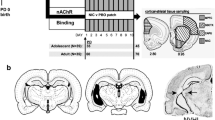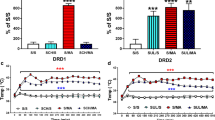Abstract
Nicotine, one of the most widespread drugs of abuse, has long been shown to impact areas of the brain involved in addiction and reward. Recent research, however, has begun to explore the positive effects that nicotine may have on learning and memory. The mechanisms by which nicotine interacts with areas of cognitive function are relatively unknown. Therefore, this paper is part of an ongoing study to evaluate regional effects of nicotine enhancement of cognitive function. Nicotine-induced changes in the levels of three neurotransmitters, dopamine (DA), serotonin (5-HT), norepinepherine (NE), their metabolites, homovanillic acid (HVA), dihydroxyphenylacetic acid (DOPAC), 5-hydroxyindoleacetic acid (5-HIAA), and their precursor, l-DOPA, were evaluated in the ventral and dorsal hippocampus (VH and DH), prefrontal and medial temporal cortex (PFC and MTC), and the ventral tegmental area (VTA) using in vivo microdialysis in awake, freely moving, male Sprague-Dawley rats. The animals were treated with acute nicotine (0.5 mg/kg, s.c.) halfway through the 300-min experimental period. The reuptake blockers, desipramine (100 μM) and fluoxetine (30 μM), were given to increase the levels of NE and 5-HT so that they could be detected. Overall, a nicotine-induced DA increase was found in some areas, and this increase was potentiated by desipramine and fluoxetine. The two DA metabolites, HVA and DOPAC, increased in all the areas throughout the experiments, both with and without the inhibitors, indicating a rapid metabolism of the released DA. The increase in these metabolites was greater than the increase in DA. 5-HT was increased in the DH, MTC, and VTA in the presence of fluoxetine; its metabolite, 5-HIAA, was increased in the presence and absence of fluoxetine. Except in the VTA, NE levels increased to a similar extent with desipramine and fluoxetine. Overall, nicotine appeared to increase the release and turnover of these three neurotransmitters, which was indicated by significant increases in their metabolites. Furthermore, DA, and especially HVA and DOPAC, increased for the 150 min following nicotine administration; 5-HT and NE changes were shorter in duration. As gas chromatography experiments showed that nicotine levels in the brain decreased by 75% after 150 min, this may indicate that DA is more susceptible to lower levels of nicotine than 5-HT or NE. In conclusion, acute nicotine administration caused alterations in the levels of DA, 5-HT, and NE, and in the metabolism of DA and 5-HT, in brain areas that are involved in cognitive processes.
Similar content being viewed by others
REFERENCES
Laviolette, S. R. and van der, K. D.2003. The motivational valence of nicotine in the rat ventral tegmental area is switched from rewarding to aversive following blockade of the alpha7-subunitcontaining nicotinic acetylcholine receptor. Psychopharmacology (plBerlin) 166:pp306–313.
Zocchi, A., Girlanda, E., Varnier, G., Sartori, I., Zanetti, L., Wildish, G. A., Lennon, M., Mugnaini, M., and Heidbreder, C. A. 2003. Dopamine responsiveness to drugs of abuse: A shell-core investigation in the nucleus accumbens of the mouse. Synapse 50:pp293–302.
Joseph, M. H., Datla, K., and Young, A. M. 2003. The interpretation of the measurement of nucleus accumbens dopamine by in vivo dialysis: the kick, the craving or the cognition? Neurosci. Biobehav. Rev. 27:pp527–541.
Rada, P., Jensen, K., and Hoebel, B. G. 2001. Effects of nicotine and mecamylamine-induced withdrawal on extracellular dopamine and acetylcholine in the rat nucleus accumbens. Psychopharmacology (Berlin) 157:pp105–110.
Carboni, E., Acquas, E., Leone, P., Perezzani, L., and Di Chiara, G. 1988. 5-HT3 receptor antagonists block morphine-and nicotineinduced place-preference conditioning. Eur. J. Pharmacol. 151:pp 159–160.
Carboni, E., Acquas, E., Leone, P., and Di Chiara, G. 1989. 5HT3 receptor antagonists block morphine-and nicotine-but not amphetamine-induced reward. Psychopharmacology (Berlin) 97:175–178.
Seth, P., Cheeta, S., Tucci, S., and File, S. E. 2002. Nicotinic–serotonergic interactions in brain and behaviour. Pharmacol. Biochem. Behav. 71:795–805.
Ventura, R., Cabib, S., Alcaro, A., Orsini, C., and Puglisi-Allegra, S. 2003. Norepinephrine in the prefrontal cortex is critical for amphetamine-induced reward and mesoaccumbens dopamine release. J. Neurosci. 23:1879–1885.
Rezvani, A. H. and Levin, E. D. 2001. Cognitive effects of nicotine. Biol. Psychiatry 49:258–267.
Picciotto, M. R. and Zoli, M. 2002. Nicotinic receptors in aging and dementia. J. Neurobiol. 53:641–655.
Beason-Held, L., Holcomb, H. H., and Tamminga, C. A. 2003. The effects of ketamine and nicotine on brain function during cognition. International Congress on Schizophrenia Research 60:212–213.
Toide, K. and Arima, T. 1989. Effects of cholinergic drugs on extracellular levels of acetylcholine and choline in rat cortex, hippocampus and striatum studied by brain dialysis. Eur. J. Pharmacol. 173:133–141.
Toth, E., Sershen, H., Hashim, A., Vizi, E. S., and Lajtha, A. 1992. Effect of nicotine on extracellular levels of neurotransmitters assessed by microdialysis in various brain regions: role of glutamic acid. Neurochem. Res. 17:265–271.
Sziraki, I., Sershen, H., Hashim, A., and Lajtha, A. 2002. Receptors in the ventral tegmental area mediating nicotine-induced dopamine release in the nucleus accumbens. Neurochem. Res. 27:253–261.
Davis, R. A. 1986. The determination of nicotine and cotinine in plasma. J. Chromatogr. Sci. 24:134–141.
Sziraki, I., Sershen, H., Benuck, M., Lipovac, M., Hashim, A., Cooper, T. B., Allen, D., and Lajtha, A. 1999. The effect of cotinine on nicotine-and cocaine-induced dopamine release in the nucleus accumbens. Neurochem. Res. 24:1471–1478.
Sziraki, I., Lipovac, M. N., Hashim, A., Sershen, H., Allen, D., Cooper, T., Czobor, P., and Lajtha, A. 2001. Differences in nicotineinduced dopamine release and nicotine pharmacokinetics between Lewis and Fischer 344 rats. Neurochem. Res. 26:609–617.
Paxinos, G. and Watson, C. 1986. The rat brain in stereotaxic coordinates. Academic Press, Florida.
Sershen, H., Hashim, A., and Lajtha, A. 2000. Serotonin-mediated striatal dopamine release involves the dopamine uptake site and the serotonin receptor. Brain Res. Bull. 53:pp353–357.
Summers, K. L. and Giacobini, E. 1995. Effects of local and repeated systemic administration of (-)nicotine on extracellular levels of acetylcholine, norepinephrine, dopamine, and serotonin in rat cortex. Neurochem. Res. 20:753–759.
Yoshitake, T., Fujino, K., Kehr, J., Ishida, J., Nohta, H., and Yamaguchi, M. 2003. Simultaneous determination of norepinephrine, serotonin, and 5-hydroxyindole-3-acetic acid in microdialysis samples from rat brain by microbore column liquid chromatography with fluorescence detection following derivatization with benzylamine. Anal. Biochem. 312:125–133.
Doherty, M. D. and Gratton, A. 1997. NMDA receptors in nucleus accumbens modulate stress-induced dopamine release in nucleus accumbens and ventral tegmental area. Synapse 26:225–234.
Bjorklund, A. and Lindvall, O. 1984. Dopamine-containing systems in the CNS. In: Björklund, A., Hökfelt, T. (eds.), Handbook of Chemical Neuroanatomy, vol 2: Classical Transmitters in the CNS, Part 1, pp. 55, Amsterdam, Elsevier.
Rahman, S., Zhang, J., and Corrigall, W. A. 2003. Effects of acute and chronic nicotine on somatodendritic dopamine release of the rat ventral tegmental area: in vivo microdialysis study. Neurosci. Lett. 348:61–64.
Johnson, J. H., Zhao, C., James, J. R., and Rosecrans, J. A. 2000. Individual variability of dopamine release from nucleus accumbens induced by nicotine. Brain Res. Bull. 51:249–253.
Iyaniwura, T. T., Wright, A. E., and Balfour, D. J. 2001. Evidence that mesoaccumbens dopamine and locomotor responses to nicotine in the rat are influenced by pretreatment dose and strain. Psychopharmacology (Berlin) 158:73–79.
Sziraki, I., Sershen, H., Benuck, M., Hashim, A., and Lajtha, A. 1998. Receptor systems participating in nicotine-specific effects. Neurochem. Int. 33:445–457.
Cohen, C., Perrault, G., Voltz, C., Steinberg, R., and Soubrie, P. 2002. SR141716, a central cannabinoid (CB(1)) receptor antagonist, blocks the motivational and dopamine-releasing effects of nicotine in rats. Behav. Pharmacol. 13:451–463.
Author information
Authors and Affiliations
Rights and permissions
About this article
Cite this article
Singer, S., Rossi, S., Verzosa, S. et al. Nicotine-Induced Changes in Neurotransmitter Levels in Brain Areas Associated with Cognitive Function. Neurochem Res 29, 1779–1792 (2004). https://doi.org/10.1023/B:NERE.0000035814.45494.15
Issue Date:
DOI: https://doi.org/10.1023/B:NERE.0000035814.45494.15




